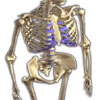Poor neighbourhoods suffer higher incidence of arthritis
Results revealed that people who live in socially disadvantaged areas were 42 per cent more at risk of getting arthritis than people in more affluent areas.
The study revealed more than 30 per cent of people living in socially disadvantaged areas reported having arthritis, as opposed to 18.5 per cent in the more affluent areas.
Led by the University of Melbourne, Deakin University and Queensland University of Technology, the study was published in the international journal Arthritis Care & Research.
Lead author, Dr Sharon Brennan from the University of Melbourne and Deakin University said of all the findings, it was location of residence that influenced arthritis prevalence the most and that it was a concerning and important finding.
“People with the condition suffer a lower quality of life. The symptoms of arthritis such as pain and immobility are debilitating,” she said.
“Our results indicate that intervention efforts to reduce arthritis may need to focus on both people and places.”
“It is widely known that obesity, age and social disadvantage are linked and are also risk factors for arthritis.”
“This is the first time a study has shown specific associations with people’s neighbourhoods which may explain that link.”
The study is the first to examine the relationship between individual and neighbourhood-level disadvantage on arthritis.
Using data from the HABITAT (How Areas in Brisbane Influence Health and Activity) cohort led by Professor Gavin Turrell of the Queensland University of Technology, researchers surveyed 10,757 males and females aged 40-65 years, selected from 200 neighborhoods of varying socio economic status in Brisbane.
Neighbourhoods, areas within suburbs, are based on Australian Bureau of Statistics Census data, which groups 200 private dwellings by proximity.
Dr Brennan said the study has important implications for policy, health promotion, and other intervention strategies designed to reduce the rates of arthritis.
“Our next steps will be to find out why there is a link to arthritis and place,” she said.
“One of the factors may be that if the environment is not conducive to physical activity, then people are less likely to be active,” she said.
In Australia, arthritis and other musculoskeletal disorders accounted for the largest proportion of direct health expenditure (31 per cent), amounting to $1.2 billion. Osteoarthritis and rheumatoid arthritis are the most common forms of arthritis.
(Source: Melbourne University: Arthritis Care & Research)
More information
 | For more information on osteoporosis, including its effect on bones and the importance of nutrition and dairy, as well as some useful videos and tools, see Osteoporosis. |
Dates
Tags
Created by:

 Login
Login














